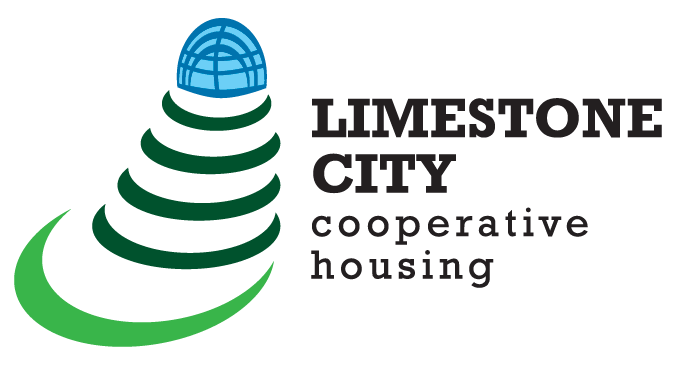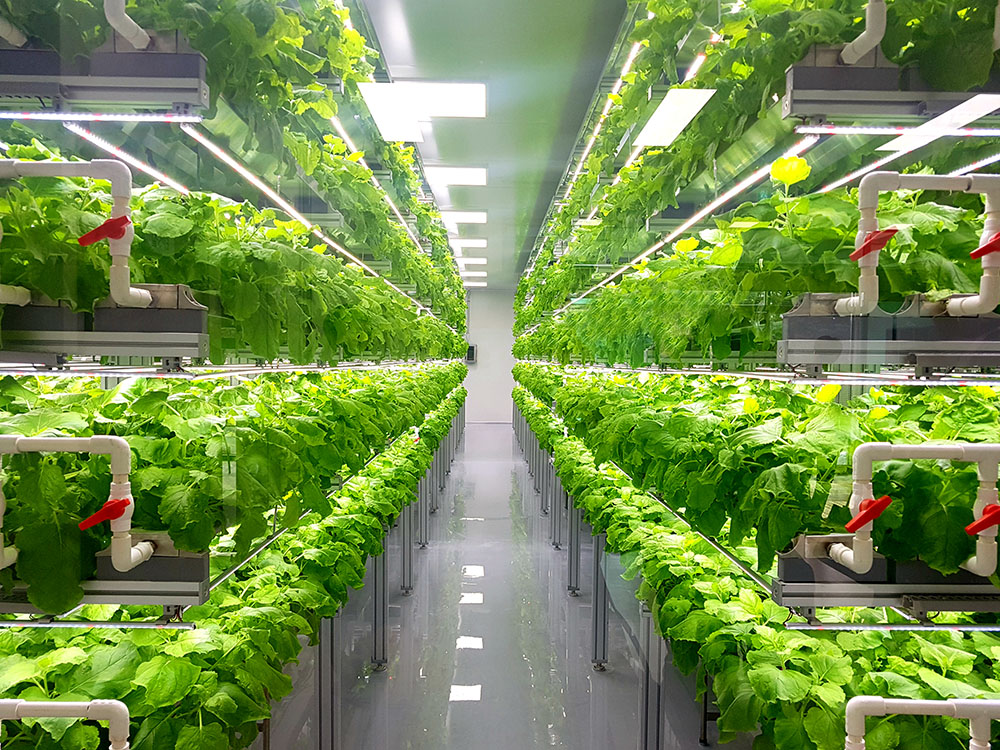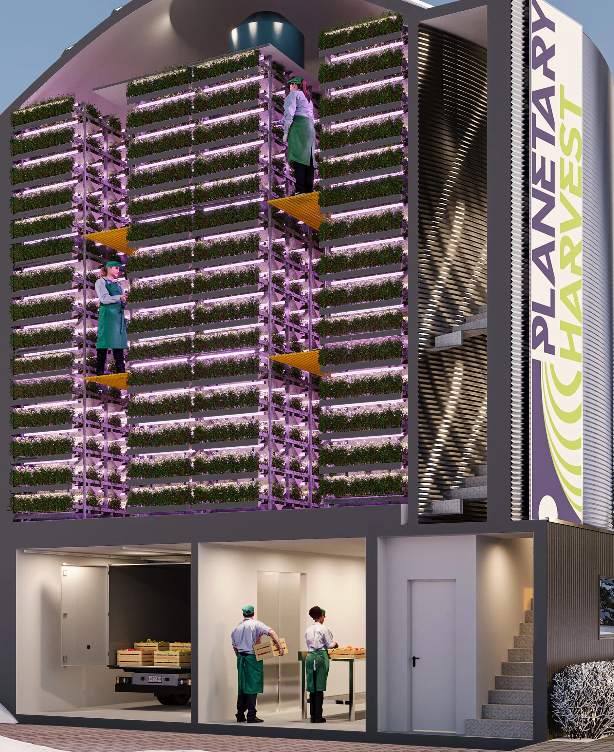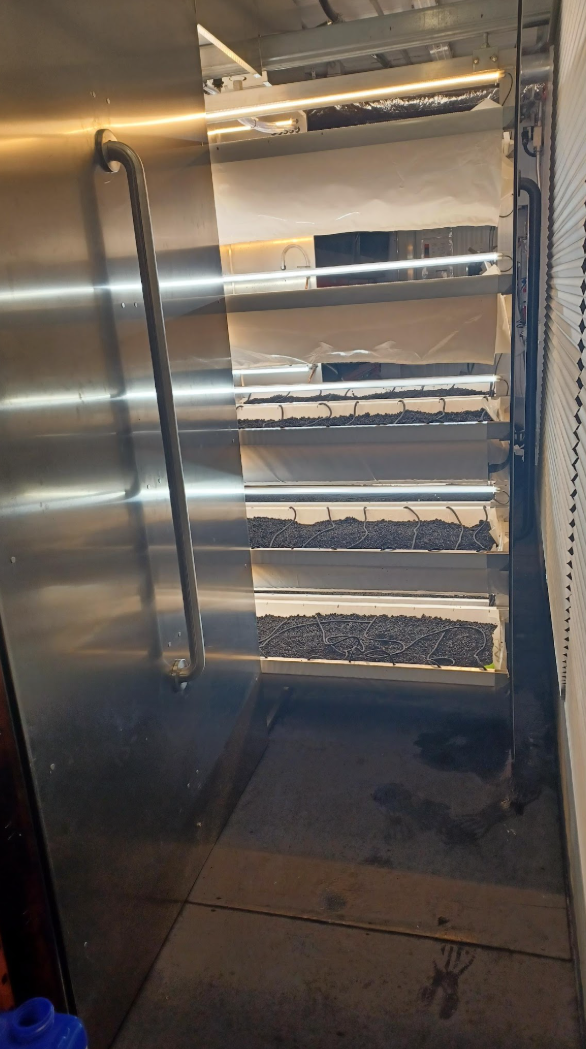Vertical Farming Vision
Vertical farming is the practice of growing food in vertically stacked layers within a controlled environment, maximizing both space and resource efficiency. At LCCH, we embrace a low-tech, labour-intensive approach. This method is intentionally community-based, user-friendly, and accessible for everyone—more like hands-on gardening than an automated industrial system.
By making food production a shared responsibility, residents actively participate in planting, cultivating, and harvesting, contributing to local economic activity, strengthening food security, and advancing food sovereignty. This approach not only produces fresh, healthy food year-round, but also fosters deeper connections—between residents, with nature, and with the wider community.
The combination of at-cost co-operative housing and a community-driven vertical farm means residents enjoy tangible benefits: reduced grocery bills, healthier meals, and the pride of knowing their efforts directly nourish their households. It’s a model that supports environmental sustainability, economic resilience, and social connection—all in one place.
Food Production Processes and Regulations
Beyond developing the indoor farming facility, equipment details, and production methods, a successful farming operation requires effective coordination of workers. A resident-based indoor farm co-op, supported by professional staff, can best manage the division of responsibilities, ensure appropriate labour qualifications, secure external resources, and provide accurate financial reporting for a sustainable operation.
Food production also demands strict adherence to Canadian and provincial regulations. Regulatory compliance will be essential, given that LCCH’s project combines both an affordable housing component and an integrated vertical farming system.
Planetary Harvest can lead the development of a comprehensive Controlled Environment Agriculture (CEA) project, including design, implementation strategy, and risk mitigation planning. This will encompass all operational and regulatory requirements to ensure the farm is productive, compliant, and sustainable for the long term.
Planetary Harvest Project’s (PHP) REVI System
Planetary Harvest has designed a low-tech, labour-intensive approach to vertical farming, adaptable for both fully indoor facilities and rooftop greenhouses. The REVI system is familiar, intuitive, and brings the experience of backyard gardening indoors for any skill level. No special tools or advanced skills are required to plant, cultivate, and harvest. Leafy greens, herbs, root vegetables, and specialty plants are all possible with REVI due to its similarity to outdoor gardening. Using granular carbon media (resembling soil), along with simple lighting, irrigation, and fertilization systems, REVI can be easily managed by residents without the need for digital systems or computer training.
- Revenue Generation: Indoor farming will create revenue streams by selling surplus produce to the local community. This revenue can be used to offset living costs, including mortgage payments and utility bills.
- Job Creation: The indoor farm creates opportunities for part-time employment, empowering co-operative members with jobs and contributing to local economic development.
- Nutritional Food Production: The REVI system will ensure a consistent supply of fresh, nutritious food, promoting healthier lifestyles for co-operative members.
- Education: The system can provide educational resources on sustainable living practices, gardening, and nutrition, fostering a culture of learning and self-sufficiency.
- Community Building: An indoor farm can become a positive focal point for community activities and gatherings, strengthening social bonds while delivering both tangible and intangible benefits.
Light and Watering Mechanisms
During a recent visit to Calgary, LCCH’s architect, Chuck, and vertical farming expert, Rich, gave us a hands-on tour of the prototype vertical farm system that will be installed in our co-op. Their two-storey model (our system will range from two to four storeys) embodies exactly what LCCH asked for: low-tech, hard to break, easy to learn, inexpensive to repair, and intentionally labour-intensive—plus a few ingenious innovations.
The most advanced element is the LED lighting. These energy-efficient strips are engineered to provide the precise wavelengths plants need for optimal growth. Each planting trough is V-shaped, reflecting light evenly and encouraging natural convection air currents. These currents gently sway the plants, mimicking the movement caused by wind—an important factor in healthy growth—while also reducing the need for powered fans.
Air circulation is handled by a simple, off-the-shelf HVAC fan, which pushes cooler air in at the bottom and pulls warmer air out at the top. Combined with the natural heat from the lights, this design works with, rather than against, natural convection. It also creates micro-climates within each stack: temperate crops can thrive at the cooler base, while tropical varieties can grow in the warmer upper levels. This diversity allows for a variety of crops rather than a monoculture. Additionally, condensation from the fan can be collected and recycled into the irrigation system.
The watering system is brilliantly simple, using ancient principles of siphons and rope osmosis. Water from a rain-collected reservoir drips at a controlled rate into a container for each planting bed. Once the container reaches its pre-set volume, the water is siphoned into the planting troughs via shoestring-like wicks. Osmosis draws the water evenly into the biochar growing medium. This design functions as a water clock—regulating both the timing and quantity of irrigation without electronics, power, or complex moving parts. The only component that moves is the drop regulation valve.
Each planting bed is ergonomically designed for easy access, with pull-out “drawer” troughs about half an arm’s length deep. This ensures that workers can tend plants without disturbing others. Each trough accommodates three furrows—one central furrow for deeper-rooted plants and two edge furrows for shallower crops. Planting is a simple two-step process: create a shallow trench with a hand trowel (careful not to disturb the osmosis wicks), drop in the seeds, and cover.
There are also future possibilities for incorporating AI to assist with plant health monitoring, providing another layer of insight without complicating the system’s core low-tech, user-friendly design.
Growing Projections
The LCCH vertical farm is designed with 163,800 vegetable positions, each capable of producing multiple harvests per year depending on the crop type.
Crop cycles vary by growth rate:
Leafy greens: ~30-day cycle → up to 12 harvests/year per position.
Root vegetables (e.g., carrots): ~90-day cycle → about 4 harvests/year per position.
Mixed crops: 4–12 harvests/year depending on crop selection and operational efficiency.
Example annual yields:
Leafy greens: 12 cycles × 163,800 positions = 1,965,600 plants/year.
Root vegetables: 4 cycles × 163,800 positions = 655,200 bundles/year.
Conservative forecast: For financial planning, LCCH uses a worst-case operational projection of 4 harvests/year regardless of crop mix. This accounts for potential losses from disease, pests, downtime, or inefficiencies. Even at this conservative rate, the farm would still produce 655,200 harvest units/year.
Revenue assumptions: Pricing is modeled at $3.50 per unit, based on observed retail prices of $3–$5 for leafy greens and root vegetables. At full retail, prices could reach $4.00/unit, improving financial returns.
Member food allocation: Allocating 20% of production to LCCH members is considered highly conservative. At this rate: 1 plant unit = 350g. Daily: 900 × 350g portions = 315 kg of vegetables distributed to 250 homes. Each home receives 1.26 kg/day (~4+ bags of mixed salad).
Given the crop diversity and potential for efficiency improvements, actual output is expected to significantly exceed the conservative projections.
Indoor Farm and Landscape Features
Our LCCH project represents a Canadian first-of-its-kind co-operative that integrates a full-scale commercial indoor farm as a shared community initiative, strengthening both member and local food security and sovereignty. The indoor farm is designed with simplified, manual processes that are practical, reliable, and user-friendly—ensuring that members of all skill levels can actively participate in and benefit from its operation.
Air Quality
Spent air from LCCH residences will be routed to the indoor farm, where plants will capture the CO2 before releasing oxygen-enriched air. By utilizing pre-conditioned residential exhaust air within the farm—and in turn, circulating farm air back into the building—energy savings can be achieved in both summer and winter. This HVAC integration has the potential to significantly reduce both energy consumption and carbon emissions while enhancing overall air quality.
Low Carbon Transportation
Transporting food into the City of Kingston generates significant greenhouse gas emissions—a challenge that will only grow as the population increases. LCCH’s full commercial-scale vertical farm can directly serve members, neighbours, and the wider community with fresh produce grown on-site, drastically reducing the need for long-distance transportation and the emissions associated with it.
Architectural Features
Because the vertical farm is integrated directly within the LCCH building, transportation of produce to residents is virtually eliminated—fresh food can move from farm to home in minutes. This central location also streamlines air circulation between residential and farm spaces, and makes it easy for members to volunteer, participate, and engage in farm operations without leaving the building.
Organic Farm Waste Composting
The City of Kingston has set goals for diverting organic waste away from landfills. The LCCH indoor farm will support this objective by composting all non-edible or unharvested plant material using a thermal digester system. The resulting compost will be re-used within the indoor farm and in residential planter boxes, creating a closed-loop system that reduces waste and enriches growing media.
Waste Heat Sharing
The waste heat generated by the indoor farm’s lighting and HVAC systems can be efficiently shared with the residential areas of the building, functioning much like a district heating system. This integrated approach enhances overall sustainability while reducing energy costs for the co-op and its members.
Water Recycling
Water demand in the indoor farm will be reduced through the recycling of HVAC condensate and irrigation water. Rainwater will also be collected and used to irrigate residential planter boxes and supplement the farm’s needs. This rainwater collection system will not only conserve potable water but also help reduce stormwater surges and mitigate the risk of storm drain flooding during increasingly frequent heavy rain events.
Indoor Farm Waste Recycling
The indoor farm will be designed to maximize material re-use, recycling, and waste minimization at every stage of production. Non-edible plant material, packaging, and other operational by-products will be repurposed or processed for beneficial use whenever possible, reducing the volume of waste sent to landfill. Systems such as composting, thermal digestion, and closed-loop water management will help ensure that valuable nutrients and resources remain within the farm’s production cycle. LCCH will also work toward achieving TRUE Certification, which recognizes facilities that implement holistic zero waste strategies by diverting at least 90% of their waste from landfills, incineration, and the environment. This certification will affirm the farm’s commitment to environmental stewardship, resource efficiency, and continuous improvement in waste reduction practices.
Key Food Production Compliance Requirements
- Canada Food Safety Regulations – Compliance with the Safe Food for Canadians Regulations (SFCR), including handling, storage, and labeling requirements for produce.
- Ontario Food Premises Regulation (O. Reg. 493/17) – Standards for cleanliness, sanitation, and operational safety in food production spaces.
- CFIA (Canadian Food Inspection Agency) Standards – Oversight for food safety, pest control, and prevention of contamination.
- Municipal Public Health Requirements – Inspections and permits from the local public health unit for on-site food handling and sales.
- Occupational Health and Safety Act (OHSA) – Worker safety standards, including training, equipment use, and workplace hazard management.
- Environmental Protection Regulations – Compliance with water use, wastewater disposal, and waste management rules, including nutrient runoff control.
- Organic Certification (optional) – If pursuing certified organic status, adherence to the Canadian Organic Standards.
- Fire and Building Codes – Ensuring indoor agricultural infrastructure meets local fire safety and building code requirements.
- Transportation and Distribution Laws – Regulations for packaging, transporting, and selling produce off-site.





